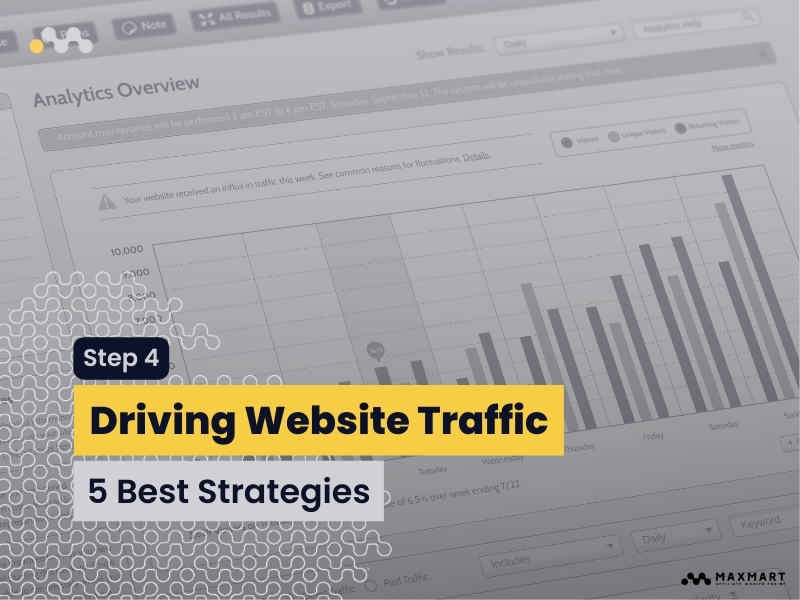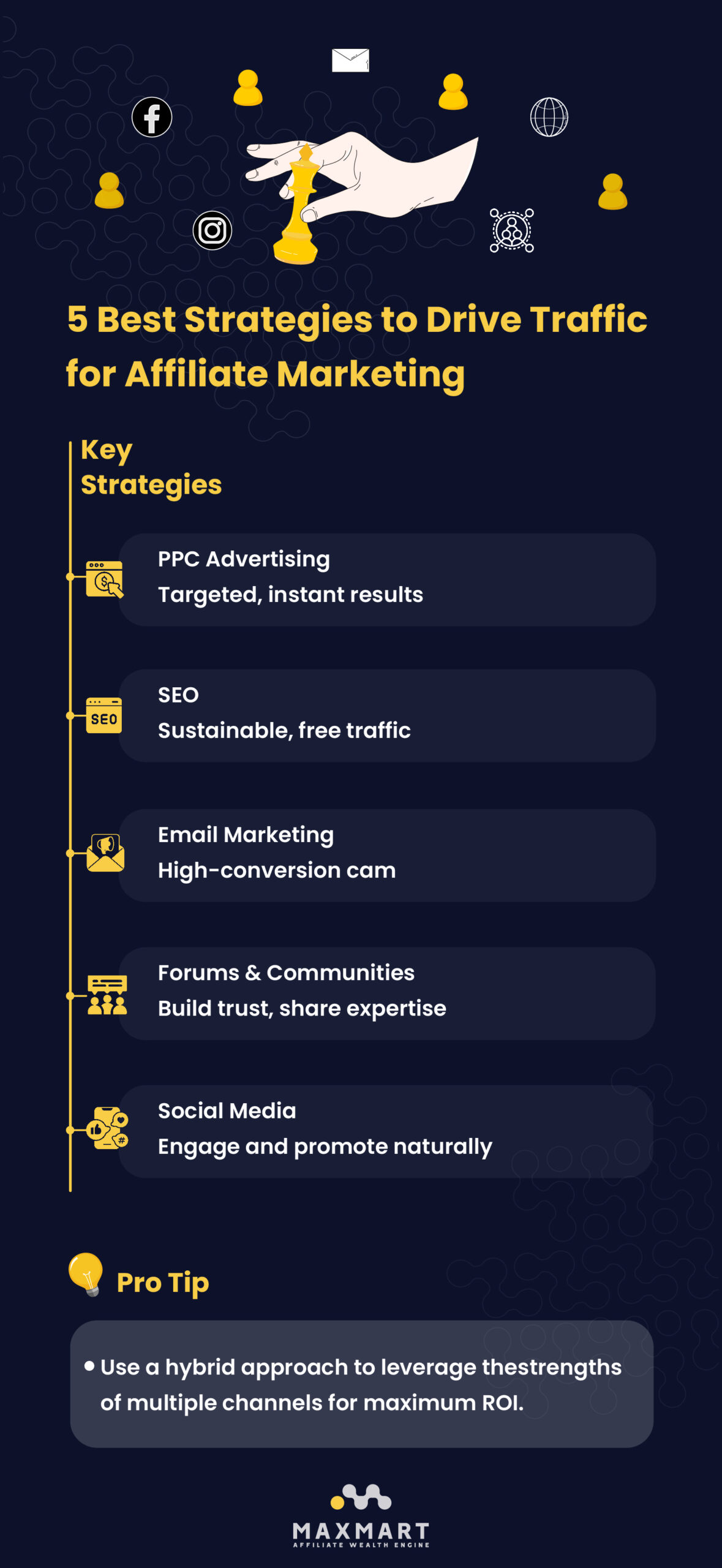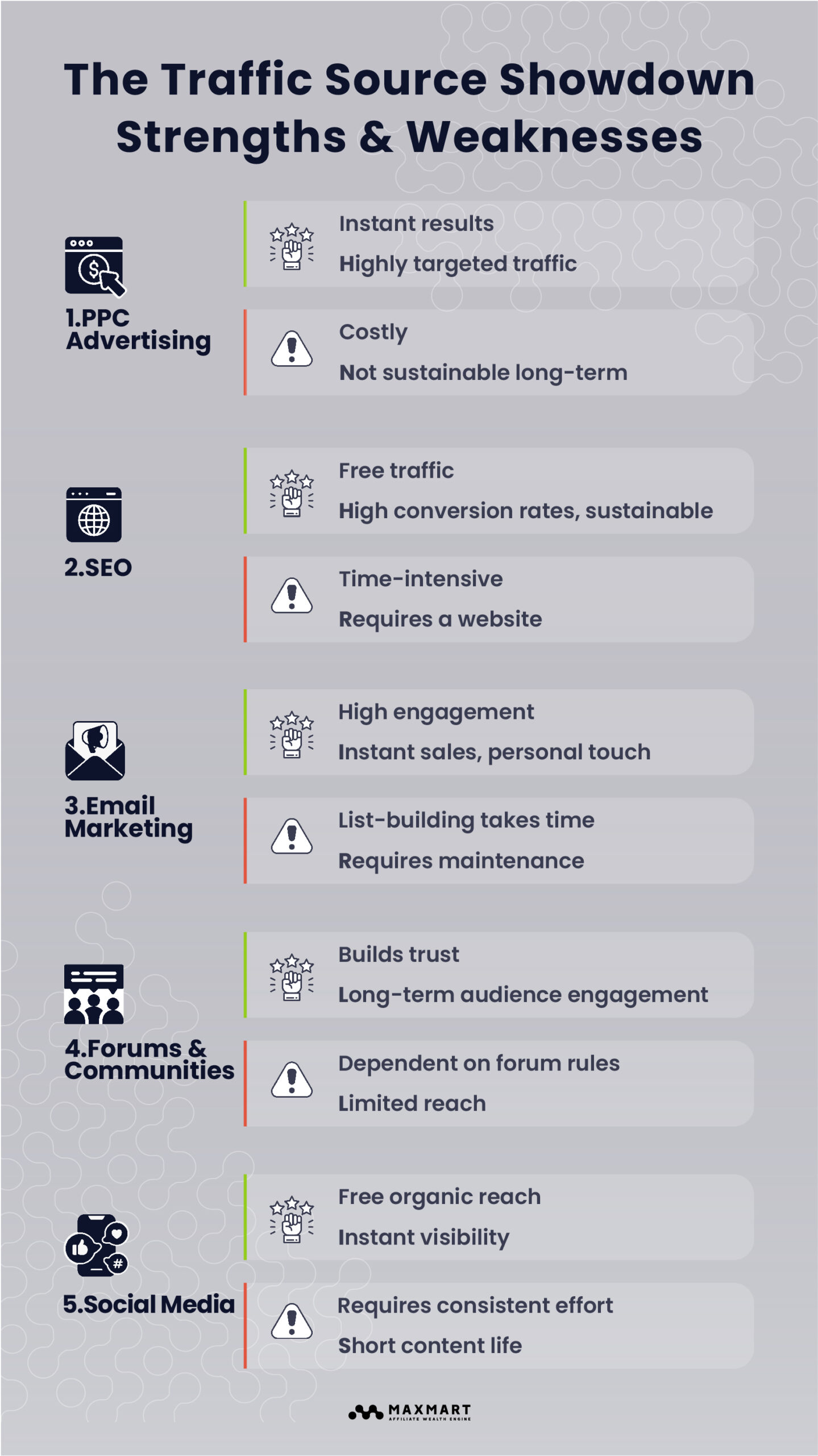
So you’re in the exciting world of affiliate marketing, ready to turn your passion into profits. But a crucial question remains: how do you attract people to click your affiliate links? This is where traffic comes in.
In affiliate marketing, traffic is the lifeblood of your business. The more targeted visitors you have, the higher your chances of conversions (sales or desired actions from visitors) and ultimately, your income.
This post dives into five of the most effective traffic sources you can leverage to drive traffic for affiliate marketing.

1. PPC (Pay-Per-Click) Advertising
Mark, a fitness blogger on “Iron Paradise,” wants to promote fitness products. PPC advertising can help!
Mark uses Google Ads to target people searching for fitness products (“best protein powder”) and those with fitness interests (healthy recipes, workout styles).
Catchy headlines (“Build Muscle at Home! 20% Off Dumbbells!”) and clear CTAs (“Shop Now”) drive clicks to his affiliate landing page.
Mark connects Google Ads with analytics to see if his ads are generating sales (conversions) for the fitness product.
PPC allows Mark to attract relevant traffic and potentially earn commissions.
How Does PPC Work?
PPC stands for Pay-Per-Click. It’s a type of internet advertising model where you only pay when someone clicks on your ad. This is a common way to drive traffic.
There are several popular platforms for PPC advertising, including:
- Search engines like Google Ads and Bing Ads
- Social media platforms like Facebook Ads, Instagram Ads, and Twitter Ads
Here is how it can drive traffic for affiliate marketing:
- You pay an advertising platform (like Google Ads or social media ads) a small fee every time someone clicks on your ad.
- You get to target your ad to show only to people who might be interested in your affiliate product like people searching for it on Google or sharing a common interest in social media.
- When someone clicks your ad (affiliate link), they get directed to a website where they can learn more about the affiliate product and maybe even buy some. This is called a conversion. In simpler terms, a conversion happens when someone clicks your ad and completes a desired action (e.g., buying, signing up, visiting the website) that the merchant has determined.
Pros:
- Generate traffic straight away: No waiting for SEO to kick in, PPC delivers immediate results.
- Targeted traffic: Reach highly relevant audiences interested in your niche.
- Don’t always need a website: You can bypass needing your website by directing your ad to the merchant’s landing page. This frees you up to focus on crafting high-performing, click-worthy ad copy.
Cons:
- Clicks can be very expensive: Competitive niches can drive high costs per click, impacting your budget.
- Hardest to justify a positive ROI (Return On Investment): Ensuring profitability with PPC requires careful campaign management and optimization.
- Typically not sustainable: PPC requires ongoing investment to maintain traffic flow, as stopping your ads means stopping the flow of potential customers to the merchant’s website.
2. SEO (Search Engine Optimization)
What if Mark chooses SEO as his traffic channel?
Mark researches search terms like “best protein powder for weight loss” to target specific needs. He creates informative blog posts like “Top 5 Protein Powders for Beginners” using those keywords naturally.
Mark optimizes his website for search engines, ensuring fast loading speed and mobile friendliness. He reaches out to fitness blogs and communities, offering guest posts that link back to his website, boosting his authority.
By consistently creating great content and building backlinks, Mark’s website climbs search engine rankings.
As his website ranks higher, people searching for fitness products find Mark’s content. They trust him, click his affiliate links, and potentially become customers for the products he promotes, earning him commissions.
How Does SEO Help Affiliate Marketing?
SEO stands for Search Engine Optimization. In simple terms, it’s about making your website easy to find in search engines like Google.
Affiliate marketing is where you promote other people’s products and earn a commission for sales.
So, how does SEO help with affiliate marketing?
- When people search for products related to your affiliate offers, you want your website to show up near the top of the search results. This is like putting those bright signs with arrows near busy streets.
- The higher your website ranks, the more likely people are to find it and click your affiliate links. This means more potential customers for your lemonade (or whatever product you’re promoting).
Here’s the key:
- By optimizing your website content with relevant keywords and building backlinks (other websites linking to yours), you improve your ranking. It’s like making sure your signs are clear, have the right words to attract thirsty customers, and point directly to your stand.
Pros:
- Free traffic: Organic traffic eliminates the ongoing costs of paid advertising.
- Targeted traffic: Attract users actively searching for products or services you promote.
- SEO is sustainable: Over time, a well-optimized website continues to generate traffic.
- Higher conversion rates: Organic traffic often converts better than paid traffic, as users are already in a research mindset.
Cons:
- Needs a website: SEO efforts focus on improving your own website’s ranking.
- SEO takes time to kick in: Building SEO authority takes consistent effort and patience.
3. Email Marketing
Now, John offers free workout guides on his website in exchange for signups and getting his audience’s Email. John’s emails aren’t just sales pitches. He shares informative content, motivational quotes, and even holds Q&A sessions, positioning himself as a trusted friend in the fitness world.
When he discovers a cool protein powder, he explains its benefits and how it aligns with his readers’ goals, including his affiliate link. John’s valuable emails and targeted recommendations are already driving traffic and building a successful affiliate marketing campaign.
How Can Email Marketing Help Drive Traffic?
Imagine you’re a sports fanatic with a collection of the latest sports gear (affiliate products) that you rave about to your friends. Email marketing in affiliate marketing is like sharing your enthusiasm and recommendations with a wider audience who might also be interested.
Here’s how it works:
- Build your Invite List: You create a list of email addresses from people who are interested in the kind of stuff you have (your affiliate niche). This is like getting people to sign up for a store membership. You can offer them free tips, discounts, or early access to new products in exchange for their email.
- Become a Trusted Friend: You send emails that aren’t just sales pitches. You share interesting content, answer their questions, and generally be a helpful resource. This builds trust and makes them more likely to listen to your recommendations.
- Recommend the Cool Stuff: When you find a truly awesome gadget (affiliate product) that fits your niche, you mention it in your emails. You explain why it’s cool and how it can benefit your subscribers. You also include a special link (affiliate link) that tracks if someone buys it from your recommendation.
- Get Rewarded: If someone clicks your link and buys the gadget, you earn a commission from the sale. It’s like getting a bonus for recommending something you genuinely like!
Pros:
- Instant sales: Targeted email promotions can lead to immediate conversions.
- Own your list: Your list is a valuable asset that allows you to monetize it by selling access to other businesses seeking to reach your targeted audience.
- High conversion rates: You’ve already established trust with subscribers who’ve chosen to receive your emails, making them more receptive to your affiliate product recommendations and higher conversion rate.
- Automated process: It streamlines the process by automatically sending bulk emails, scheduling them for optimal delivery times, and tracking their performance metrics, all without requiring manual intervention for each stage.
Cons:
- Building up an email list is not easy: Growing an engaged email list requires consistent effort and valuable content.
- Building up a list takes a long time: Don’t expect overnight success in building a sizable email list.
- You only generate sales when you send an email: Sending recommendations via email can lead to some conversions, but it’s not a sustainable traffic generation strategy.
4. Forums and Online Communities
Now imagine Mark is using forums to drive traffic for his affiliate marketing efforts. He’s set his sights on “Iron Paradise,” a renowned weight training forum.
Mark doesn’t just jump in with promotions. He spends time lurking, absorbing the common questions and challenges faced by the community. This allows him to craft well-informed replies when the opportunity arises.
He compares protein supplements, analyzes different workout routines, and offers valuable insights. He only mentions his affiliate links for products he genuinely believes in, and only after providing his expertise. This focus on building trust and offering value makes his recommendations stand out, encouraging forum members to click his links.
Forums Strategy Explained
Imagine you’re hanging out in a club for people who share your hobby. Everyone there is interested in the same things, so if you mention a cool new gadget related to your hobby, people might be more likely to listen and even buy it.
Forums and online communities are like those clubs, but online! In affiliate marketing, the “club” is a forum or online community focused on your niche. Here’s how it works for affiliate marketing:
- Find the right online hangout: Look for forums or communities where your target audience chats and asks questions about the products you promote.
- Become a helpful member: Don’t just jump in and start promoting stuff. Answer questions genuinely, share your knowledge, and build trust with the community.
- Subtly recommend products: When appropriate, you can mention affiliate products you genuinely like as solutions to problems people are discussing.
You’re offering value first and then, when it makes sense, suggesting helpful products. This way, people are more likely to trust your recommendations and click on your affiliate links.
Here’s the key thing to remember: You don’t own the online community. You’re a guest in their space, so always follow their rules and avoid being too promotional.
Pros:
- Work incredibly well when providing value: Building trust and authority leads to organic interest in your recommendations.
- Leverage the domain authority of the forum: The forum’s high domain authority can also benefit your affiliate link and website. Also, since the forum is trusted and well-regarded (by search engines), your forum post has a greater chance of appearing at the top of search results.
- Effective long-term strategy: Consistent engagement fosters relationships that can convert over time.
Cons:
- Not all posts are auto-approved: Forum moderators may review your content before publishing.
- Income directly linked to forum size: The more people who participate in the forum, the more you can earn.
- You don’t own the property: The forum platform ultimately controls your content and audience reach.
5. Social Media
On Instagram and YouTube, Mark creates engaging content: workout routines, healthy meals, and progress pics (with affiliate links!). Her YouTube tutorials demonstrate exercises using specific equipment (linked in the description).
Mark prioritizes valuable content. He occasionally mentions products he loves, including his affiliate link naturally. As her audience grows, some will click and buy, earning Mark a commission.
Social media is a powerful tool. By being a reliable source and recommending products genuinely, Mark builds trust and creates a win-win for her and the brands.
Social Media Strategy Explained
This is where you use platforms like Facebook, Instagram, or YouTube to connect with a big audience.
Now, social media marketing in affiliate marketing is all about using those social media platforms to spread the word about the products you like and earn commissions for sales. Here’s how it works:
- Pick a niche: You choose a specific area of interest, like fashion, fitness, or gaming.
- Find affiliate programs: Look for companies in your niche that offer affiliate programs. These programs give you a special link or code to track sales from your audience.
- Build a following: Create engaging content on social media related to your niche. This could be funny memes, helpful tutorials, or product reviews.
- Promote with a sprinkle of affiliate links: Casually mention products you love and include your affiliate link in your posts or descriptions.
- Followers buy, you earn! When someone clicks your link and completes a desired action, you earn a commission.
Think of it this way: You’re like a trusted friend recommending something awesome, and social media helps you reach a much bigger audience than just your social circle.
Pros:
- Free traffic (organically): Building a following allows you to reach a large audience without upfront advertising costs.
- Instant sales: Social media promotions can drive instant sales, especially with platforms that facilitate direct purchases within the app.
Cons:
- To get good results you need to have an audience: Building a sizable audience takes consistent content creation and engagement.
- You don’t own the property: Social media platforms control the algorithms that dictate your reach.
- Social media posts have a short shelf life: Content gets buried quickly by newer posts, requiring constant activity.
- Conversion rates are not the best: Social media users may be less receptive to direct sales compared to other channels.
The Traffic Source Showdown: One Channel to Rule Them All?

You’ve explored the strengths and weaknesses of PPC, SEO, email marketing, forum participation, and social media. Now you might be wondering: is there a single best traffic source for affiliate marketing?
The truth is, there’s no one-size-fits-all answer. Each channel has its advantages and caters to audiences in different stages of the buying journey. Here’s why a hybrid approach – leveraging a mix of these channels – is the ultimate winner:
- Multi-Channel Reach: Imagine a prospect needing that perfect pair of running shoes. They might search online reviews (SEO), see an ad on social media (PPC or Social), and then subscribe to an email list for a discount code (Email Marketing). By using a mix of channels, you increase your chances of capturing their attention at various touch points. Each channel strengthens the others, creating a powerful and cohesive brand experience.
- Data-Driven Optimization: With a multi-channel approach, you gain valuable data on what resonates most with your audience. You can then optimize your efforts in each channel, allocating resources for maximum return on investment (ROI).
While some channels might deliver faster results (PPC ads), others like SEO build long-term, sustainable traffic. By combining them, you create a well-rounded strategy that drives consistent traffic and conversions.
So, ditch the search for a single “best” channel. Embrace the power of a hybrid approach and watch your affiliate marketing efforts soar!
Conclusion: A Traffic Symphony, Not a Solo Act
You’ve explored the top traffic sources for affiliate marketing, delving into the unique strengths and considerations of each. As you ponder your strategy, remember: there’s no single “best” channel.
Think of it like an orchestra. Each instrument (PPC, SEO, email marketing, forums, social media) brings its melody and plays a crucial role in the overall symphony. By harmonizing these channels, you create a powerful and captivating performance that attracts a wider audience and drives conversions.
Here’s your action plan:
- Identify your target audience: Understand their online behavior and preferred channels.
- Start with a strong foundation: Focus on SEO to build organic traffic and establish your brand as an authority.
- Experiment and diversify: Gradually incorporate other channels based on your audience and budget.
- Track and analyze: Monitor performance and adjust your strategy to maximize results.

MaxMart will help you navigate the options, from organic search optimization to strategic social media campaigns. With MaxMart’s expertise, you’ll learn how to choose the channels that best reach your target audience and execute them effectively. Below, you can click on each channel to get more in-depth details about them and how to execute them like a pro!

